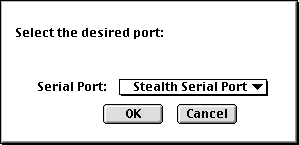Review: Stealth Serial Port

Developer: GeeThree.com
Price: $49.95
Requirements: iMac, Blue and White Power Mac G3, or Power Mac G4
.The migration to USB has been an interesting experience for many Mac users. Indeed a plethora of USB devices has sprouted up, and several Mac Serial to USB converters are now available. Yet many users are faced with legacy devices, many of which do not function properly when interfaced with a Serial to USB converter.
Apple MIDI is one such example—Apple has not updated their drivers in ages, and hence they do not work with USB MIDI adapters. Many applications require Apple MIDI and do not work with other third party MIDI drivers such as Free MIDI or OMS (Open MIDI System). What should a user who depends on Apple MIDI do if he wants to use a new USB-only Macintosh? What should users in similar situations do? The new Macs are irresistible, but legacy devices always complicate the decision to purchase a new machine. Stealth Serial Port to the rescue.
The Stealth Serial Port is a $50 card that plugs into the comm slot found on the iMac, Blue and White G3, and G4 computers. It provides a standard Mini DIN-8 Serial port (note—the Stealth Serial port does not support GeoPort devices, which require a 9th pin). The only bad news is that because the Stealth card uses the comm slot in your box, you will lose the internal modem. That’s not such a bad thing in my opinion. I never liked internal modems to begin with (don’t get me started). When I had my G4 built at the Apple Store I knew that I would be purchasing a Stealth Serial Port so I purchased it without the modem. If you need a modem, there are numerous external USB models from which to choose, and in the end you won’t be spending much more, if any, for an external modem.
Installing the card is absurdly simple. If you have a B&W G3 or G4 the procedure requires about two minutes. For iMacs it’s a bit more involved but still quite manageable.
That the Stealth Serial Port uses the comm slot is of critical importance with respect to its superlative compatibility. The driver included with the Stealth card simply hooks into the Comm Toolbox, providing another port selection in the port pop-up menu of any Comm Toolbox savvy application. For older applications, simply choosing the Modem port will work. Apple has cleverly patched the Modem port to the comm slot so that older applications will work with the internal modem (this has been common practice since the days of the first internal modems in Apple’s laptops).

Does it work? Yes! It works superbly. I have used it with both Comm Toolbox-savvy and older applications; both find the Stealth port and use it without fail. The port supports the faster speed of 230.4K transmission, which is good news if you are forced to use the serial port for digital camera transfers, for example. Also supported is Ethernet to LocalTalk bridging, so you can network an old LocalTalk printer on an Ethernet network. Even that Godforsaken Apple MIDI works now! I have yet to find a program, no matter how old, which does not work perfectly with the Stealth Serial Port.
I have followed discussions regarding competing cards, and it has become evident to me that the GeeThree product is by far the best choice. Other cards are apparently not as compatible—and I have yet to hear any complaints regarding the Stealth board. When compared to Serial to USB converters the GeeThree card always comes out ahead. And often it is cheaper.
Any complaints? In terms of functionality, no. The card does what it says it will, and it does it perfectly. The manual is appropriately short but easy to follow, and it will allow even the novice to install the board. The driver is a tiny little extension with next to no memory overhead. I cannot find any problems with the card.

The only way to improve upon the product would be to somehow design a similar board with both an internal modem and serial port. Such a card would then provide an accompanying driver that would allow Comm Toolbox applications to choose between Internal Modem and Stealth Port, and there would be a control panel allowing the user to choose which port to map old style modem port requests. This would be perfection…but I cannot penalize the folks at GeeThree for not providing a product I just thought up off the top of my head.
I can summarize this review quickly for you: the Stealth Serial Port is about as perfect a product as I’ve encountered, at least from a hardware standpoint. Its perfection is a result of its simplicity, but it is nevertheless flawlessly executed and the price is tough to beat. Thankfully, we are leaving the days of the serial port behind us, but many Mac users will nevertheless encounter the need for one. Should that need arise, rest assured that the GeeThree will come to the rescue in fine style.

Reader Comments (11)
RG
[email protected] (substitute ejl for xxx)
Thanks.
Brian Catt
01932 772731
Skype CattHouse
Please help, I need to connect printer to laptop. Johnny
Add A Comment